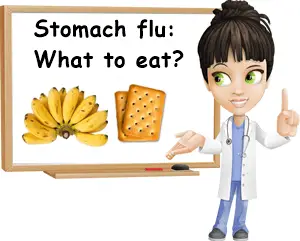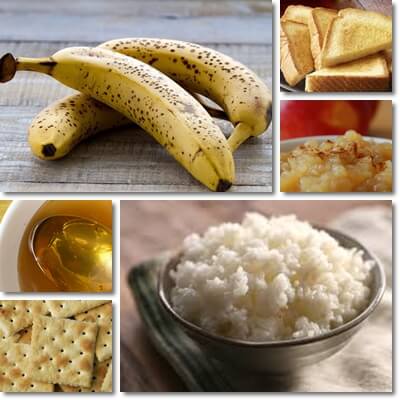Recovering from the stomach flu is all about the foods you eat and avoid as much as it’s about staying well hydrated. Bland foods that are easy to digest such as toast, croutons, crackers, plain boiled rice, applesauce or very ripe bananas are ideal foods to eat when you have the stomach flu, whilst meat, milk and dairy and all heavy and heavily flavored foods are best avoided until your stomach has recovered enough to resume normal digestion. It’s recommended to eat small meals often and replenish fluids and electrolytes lost through vomiting and diarrhea by drinking still water or naturally sparkling water, tea, a sports drink of your liking, eating clear chicken soup or taking powder rehydration solutions.
What is the stomach flu and what does it do?
The correct medical term for stomach flu is infectious gastroenteritis. It refers to an inflammation of the mucous membranes lining the stomach and intestines caused by infection with a virus, bacteria or, in some cases, intestinal parasite or, more rarely, fungus. Typically, no treatment is needed for gastroenteritis caused by a virus, but bacterial gastroenteritis may be treated with antibiotics while fungal gastroenteritis with antifungal medication and parasitic gastroenteritis with antiparasitic medication. The most important aspect however is to manage symptoms, especially vomiting and diarrhea which cause dehydration.

Dehydration is the root of most complications of the stomach flu. And what you eat and drink is essentially going to determine how fast stomach flu symptoms will improve and how quickly the infection will pass. While the main focus should primarily be drinking lots of fluids and replenishing lost electrolytes, eating the right foods is also a vital aspect of the recovery process. There are actually two parts to the stomach flu: the period of time when the infection is active and the period of time following the infection, or the recovery period. Both require a strict diet plan consisting of limited amounts of bland foods and lots of fluids.
So What are the best foods to eat when you have the stomach flu?
Ideally, what you want to eat when you have a gastroenteritis virus is bland foods with little to no taste or smell so they do not trigger nausea and, consequently, vomiting and are easy to digest, such as:
1) Plain toasted bread, preferably light toasted.
2) Crackers, no flavor. Salted crackers or saltines are even better because they contain sodium to replenish the amounts lost through diarrhea and vomiting.
3) Plain boiled white rice or pasta.
4) Applesauce, unflavored, unsweetened.
5) Stewed apples, quinces or pears.
6) A fresh, chilled apple with or without skin, if your stomach allows it.
7) Very ripe bananas (golden throughout with brown spots).
8) Clear chicken soup (just the liquid, without vegetables or meat).
You can eat it with risoni or orzo, a pasta shaped like rice grains.
9) A teaspoon of manuka honey or other honey varieties to prevent low blood sugar.
Do not eat honey if you are allergic to it or other bee products.
The rice, toast and crackers help bind stools and make them firmer which helps improve diarrhea. The applesauce and stewed apples contain a fiber called pectin which also helps bind stools and stop diarrhea naturally. The fresh chilled apple is great for when you have nausea because it contains malic acid, while the ripe bananas are easy on the stomach and contain both potassium and magnesium, two important electrolytes lost through vomiting and diarrhea. The clear chicken soup is great for counteracting dehydration and is only lightly flavored from the vegetables and chicken meat. Lastly, the honey is great for when you can’t eat because it contains sugar and helps prevent hypoglycemia and fainting.

What can you eat with the stomach flu?
There is a big difference between what you should eat and what you can actually eat when you have the stomach flu. A lot of people with the stomach flu can’t eat anything the first day while some can’t eat almost anything the first 2-3 days. Those who can eat, will often only eat very small amounts of food at once. If you eat too much during the first days, there is a high chance you’ll vomit because the stomach isn’t ready to process normal amounts of food. In order to be able to keep food and water down, remember to:
1) Eat very small amounts of food at once. For example, two slices of toast with maybe a teaspoon of honey or half of a small bowl of plain boiled rice or one or two stewed apples or a very ripe banana. Remember that your stomach is irritated and cannot digest food as it normally does and too much food at once can result in vomiting.
2) Eat often. Because you can’t eat a full meal, it’s important to eat often to prevent low blood sugar levels and fainting. Even half an apple or half a banana or four tablespoons of plain rice every 2-3 hours are better than nothing. So eat whenever you feel you can, but never fill up on food.
3) Do not force yourself to eat anything you don’t like. You don’t feel like eating applesauce or the smell of ripe bananas makes you feel nauseous? Then have some saltines or a slice of toast. It’s better you keep toast down than eat applesauce and vomit.
What should you eat after a stomach bug?
Even if the infection is over, your digestive system may still need time to recover and get back to its normal self. You can help it by slowing diversifying your diet. Essentially, the best foods to eat after a stomach bug are the same as those you eat during the stomach bug, which is light foods with little to no flavor.
In addition to the foods listed above, the after-gastroenteritis diet plan includes:
1) Whole chicken soup with liquid, vegetables and lean chicken meat.
2) Cooked vegetables such as boiled carrots, spinach, potatoes, string beans or celery root (check for allergies).
Avoid peppers, onions and other strong spices or flavors for the time being.
3) Plain rice with vegetables or chicken.
4) Soft boiled eggs.
5) Mashed potatoes, without butter, milk or oil, just salt.
6) Boiled white, lean fish like aurata (avoid salmon, tuna or other oily fish until you recover).
7) You may try to incorporate small amounts of fresh cottage cheese or plain yogurt in your diet to help rebuild good gut bacteria. These are best eaten with toast or crackers to prevent stomach acidity.
Once you feel you have recovered completely, you may resume your usual diet and eat more solid and satiating food.
What not to eat and drink when you have the stomach flu?
Here are the foods and beverages to avoid:
1) Caffeine and caffeinated beverages (coffee, green tea, black tea, white tea, oolong tea).
2) Fried foods and fatty foods.
3) Meats, especially red meat and cured meats.
4) Milk, dairy, fish and seafood.
5) Pickles, vinegar, anything acidic or extremely fermented which can upset the stomach.
6) Spices (turmeric, ginger, pepper, chili peppers, horseradish, wasabi and others).
7) Pungent vegetables: onions, garlic, leek, chives, cabbage etc.
8) Processed foods of any kind, from candy and pastry to ice cream, chips and frozen meals.
9) Chocolate, cocoa.
10) Fizzy drinks or carbonated beverages, alcohol, energy drinks.
11) High fiber fruits and vegetables (they can worsen diarrhea and dehydration).
The reason why no fruits or vegetables, except for maybe apples, bananas, stewed quinces or the occasional stewed pear, should be eaten when you have the stomach flu is because they are rich in dietary fiber which further loosens stools, accentuating diarrhea. Some, like pineapple, are especially not good for the stomach flu. This is because pineapple and pineapple juice contain an enzyme called bromelain which can irritate the stomach lining. Fruits like watermelon aren’t good when you have the stomach flu either. While they may be a great source of water, they may also spoil quickly and you risk foodborne illness in addition to the gastroenteritis. Cabbage family vegetables like broccoli, cauliflower or cabbage should also be avoided until normal digestive function returns because they cause bloating and have laxative properties.
At the same time, some people report taking a sip or two of their favorite soda helped them fight nausea and allowed them to eat. Taking effervescent vitamin C, especially natural vitamin C made from rose hip or acerola cherry can also help restore appetite and combat dehydration. For me personally, taking aloe vera extract on an empty stomach has lead to a significant improvement in symptoms and a faster recovery.
Stomach flu: what to drink?
Anyone with the stomach flu should focus on drinking as much fluids as they can in order to replenish what they lost as a result of the diarrhea and vomiting. Some great options include:
1) Still water. May be plain or flavored with a bit of lemon juice, peppermint or honey to combat nausea.
2) Naturally sparkling water. It contains electrolytes (sodium, potassium, magnesium, calcium) that prevent dehydration, low blood pressure and fainting.
3) Oral rehydration solution. Great solution for all degrees of dehydration.
4) Peppermint tea (diarrhea and nausea), ginger tea (nausea), licorice tea (helps retain sodium, prevents fainting). Avoid teas with laxative properties and those containing caffeine.
5) Clear chicken soup seasoned with a little salt.
6) Fresh, home-made fruit juices if you have low blood sugar levels and crave something sweet. Best made without fruit skin to reduce fiber intake. Should be consumed in limited amounts.
